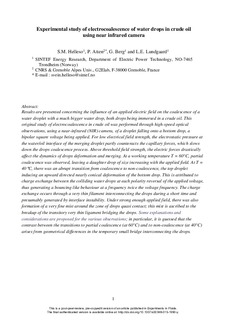| dc.contributor.author | Hellesø, Svein Magne | |
| dc.contributor.author | Atten, Pierre | |
| dc.contributor.author | Berg, Gunnar | |
| dc.contributor.author | Lundgaard, Lars Esben | |
| dc.date.accessioned | 2018-04-26T12:07:45Z | |
| dc.date.available | 2018-04-26T12:07:45Z | |
| dc.date.created | 2015-06-08T14:00:29Z | |
| dc.date.issued | 2015 | |
| dc.identifier.issn | 0723-4864 | |
| dc.identifier.uri | http://hdl.handle.net/11250/2496146 | |
| dc.description.abstract | Results are presented concerning the influence of an applied electric field on the coalescence of a water droplet with a much bigger water drop, both drops being immersed in a crude oil. This original study of electrocoalescence in crude oil was performed through high-speed optical observations, using a near-infrared camera, of a droplet falling onto a bottom drop, a bipolar square voltage being applied. For low electrical field strength, the electrostatic pressure at the water/oil interface of the merging droplet partly counteracts the capillary forces, which slows down the drop coalescence process. Above threshold field strength, the electric forces drastically affect the dynamics of drop deformation and merging. At a working temperature T = 60 °C, partial coalescence was observed, leaving a daughter drop of size increasing with the applied field. At T = 40 °C, there was an abrupt transition from coalescence to non-coalescence, the top droplet inducing an upward directed nearly conical deformation of the bottom drop. This is attributed to charge exchange between the colliding water drops at each polarity reversal of the applied voltage, thus generating a bouncing-like behaviour at a frequency twice the voltage frequency. The charge exchange occurs through a very thin filament interconnecting the drops during a short time and presumably generated by interface instability. Under strong enough applied field, there was also formation of a very fine mist around the zone of drop quasi contact; this mist is ascribed to the break-up of the transitory very thin ligament bridging the drops. Some explanations and considerations are proposed for the various observations; in particular, it is proposed that the contrast between the transitions to partial coalescence (at 60 °C) and to non-coalescence (at 40 °C) arises from geometrical differences in the temporary small bridge interconnecting the drops. © Springer-Verlag Berlin Heidelberg 2015 | nb_NO |
| dc.language.iso | eng | nb_NO |
| dc.publisher | Springer | nb_NO |
| dc.rights | Navngivelse 4.0 Internasjonal | * |
| dc.rights.uri | http://creativecommons.org/licenses/by/4.0/deed.no | * |
| dc.title | Experimental study of electrocoalescence of water drops in crude oil using near-infrared camera | nb_NO |
| dc.type | Journal article | nb_NO |
| dc.type | Peer reviewed | nb_NO |
| dc.description.version | acceptedVersion | nb_NO |
| dc.rights.holder | Authors have copyright to accepted version | nb_NO |
| dc.source.volume | 56 | nb_NO |
| dc.source.journal | Experiments in Fluids | nb_NO |
| dc.source.issue | 122 | nb_NO |
| dc.identifier.doi | 10.1007/s00348-015-1990-y | |
| dc.identifier.cristin | 1246898 | |
| dc.relation.project | Norges forskningsråd: 206976 | nb_NO |
| dc.relation.project | Norges forskningsråd: 169466 | nb_NO |
| cristin.unitcode | 7548,30,0,0 | |
| cristin.unitname | Elkraftteknologi | |
| cristin.ispublished | true | |
| cristin.fulltext | postprint | |
| cristin.qualitycode | 1 | |

